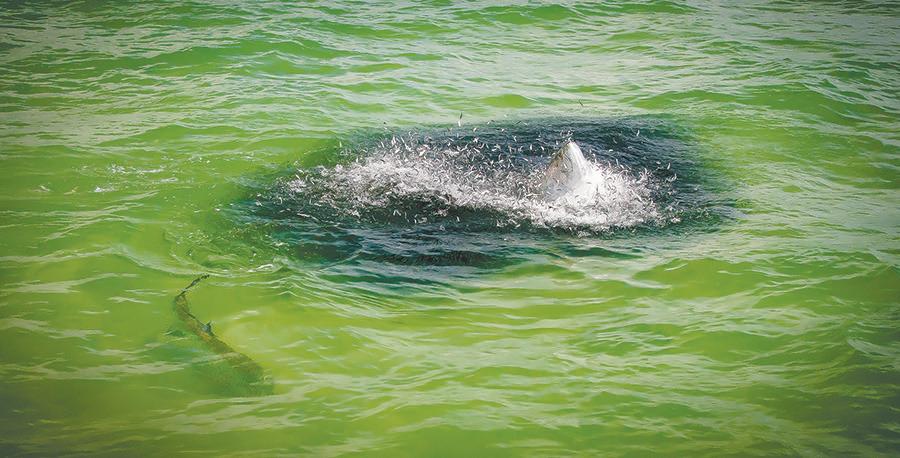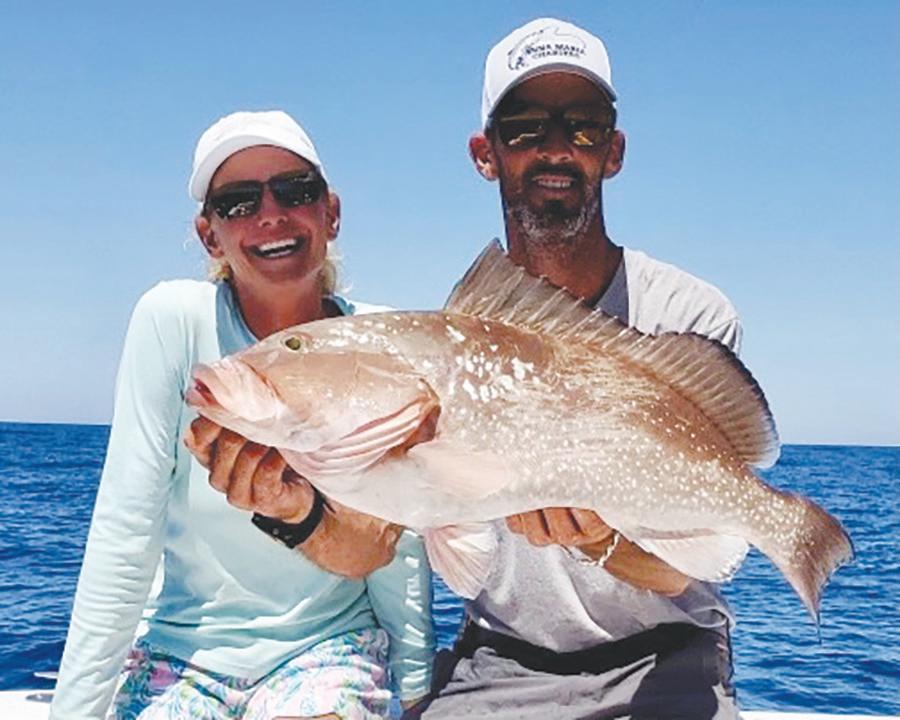
18 minute read
OUTDOORS
20 THE SUN OUTDOORS
Get ready and get involved
Reel Time
RUSTY CHINNIS
Tarpon were the sirens that lured the first tourists to Florida, and their mystique is still in full sway today.
While fly fishing for tarpon holds a mystique of its own, the vast majority of anglers pursue them with conventional tackle. The go-to bait for spin anglers is a live crab. Small blue crabs can be purchased at most bait shops during tarpon season and pass crabs can be dipped from the local passes on a falling tide. Other effective baits include pinfish, threadfin herring and pilchards. Artificial lures like the DOA Bait Buster and the 4- and 6-inch shrimp, jigs and even top water plugs can be effective.
Patience is a critical factor when fishing for tarpon, especially when fly fishing. The most successful anglers find the edge of a sand bar or other underwater feature that tarpon track, anchor in casting range and wait. Sometimes tarpon come at a steady rate, but just as often there are long periods of time when the only thing to look at is the water and the bottom. This really separates the great anglers from the good anglers. There are times when you need to move but knowing when and where is a skill that is developed, if never mastered.
Once set up, the angler must be able to make a 40- to 50-foot cast to a location the size of a dinner plate. Placement of the fly cannot be overemphasized, because tarpon will seldom vary a foot or two from their path to eat a fly. Although there is always the rare exception, a fly must never travel in a path towards the intended target. A tarpon’s prey species wouldn’t survive long if it moved toward its aggressor, and tarpon know it. Besides moving away from the fish, the fly must move at the proper pace, be at the proper depth and never slow down when a tarpon is tracking it. Conversely, you can’t move the fly too fast, taking it out of a tarpon’s range.
Conventional anglers usually look for rolling fish in the near-shore Gulf and motor well ahead of them to intercept their path. Trolling motors can be effective for following a school in deep water but will spook them in the shallows. Knowledgeable guides that have “mastered” multiple presentations to a school of moving fish provide their clients some spectacular results. One thing that all tarpon anglers should practice is courtesy. Often a boat has been working long and hard to get properly set up for a shot and a boat running up on the fish will spoil the day for everyone.
Fortunately, once a tarpon decides to eat, there’s no need to make a lightning-fast hook set. The right set is called a “strip strike” in fly fishing, which involves letting the line come tight and immediately setting the hook with a combination of the line hand and the rod. Conventional anglers should also have the patience to let the line come tight before attempting to hook the fish. Then the angler must at once work to set the hook in the cement-like jaw while being ready for the fish to bolt away from the boat. Tarpon are not trout, and attempting to raise the rod to set the hook is a cardinal mistake.
After a fly angler sets the hook, attention must go immediately to clearing the line (getting the loose line off the deck). In most cases, the angler has been stripping in line when the fish bites and the hook is set. That line can easily foul on the angler, the rod or the reel. Disciplined anglers (successful ones) take their attention from the fish to the line at your feet. They know to hold the rod away from their body and let the excess line pass through their stripping hand with a circle made with the thumb and the forefinger. Once the line is “on the reel,” the hook is set again with several more strip strikes. Conventional anglers often use circle hooks, which don’t require a hook set. Conventional hook sets also require letting the line come tight with the addition of several quick jabs to set the hook. In all cases, the tarpon cannot be aware of the angler before the hook set.
While it’s important to exert maximum pressure on the tarpon during the fight, anglers must yield on jumps. On the jump, the standard maneuver is to thrust the rod forward to relieve pressure on the line. This prevents the tarpon from breaking off if it lands on a taut line. This maneuver is known as “bowing to the king.”
It’s customary to start the engine and get as close to the tarpon as possible after the initial and subsequent long runs. This allows the angler to apply maximum pressure. If a tarpon is a hundred yards from the boat, the stretch of the line makes it impossible to apply any real pressure. Keep the pressure on throughout the fight, but don’t clamp down and try to force the fish to the boat.
The thought that these next few months, the highlight of mine and many other angler’s year, might be sacrificed to the onslaught of a harmful algae bloom is a painful reminder. While there are many bad actors to blame for this misfortune, if we don’t speak up and act, nothing will change until after a disaster. Piney Point is the perfect example. Call your elected officials, attend commission meetings, write letters to the editor, and more importantly, become an active advocate.
Perhaps the best strategy of all is to get excited about, look forward to and get ready for a magical time of the year. While we’re at it, we’ll let the passion fuel our determination to protect it.

It’s tarpon time again in the Gulf of Mexico.
RUSTY CHINNIS | SUN






Inshore action good despite wind
CAPTAIN DAVE WHITE
Will the wind ever stop!? That’s the question local guides are asking themselves lately. The winds have kept us from fishing offshore. But luckily, we find places to hide for a bit for our inshore charters. We’ve been doing well on snook, trout, and redfish. It’s not unclipped lately for our anglers to get the “slam” lately. All three of these species are catch and release right now.
For anglers wanting some groceries, we’re targeting Spanish mackerel, mangrove snapper, and black drum. The snapper are starting to show up a little bit more every day. And they’re getting bigger as well! We’re starting to see a few tarpon here and there, as well. We get excited about these guys! Hopefully, this one will stabilize and we will be able to start chasing large schools of these fish on the beach.
CAPTAIN RICK GRASSETT
Tarpon fishing will take off during May as migratory fish arrive along our beaches. Also, look for Spanish mackerel, tripletail, cobia and false albacore (little tunny) in the coastal Gulf. Snook will move into passes and the surf and reds and trout should feed heavily on shallow flats as baitfish become more plentiful. Trout, blues, Spanish mackerel and more should be good options on deep grass flats.
Resident tarpon are usually the first to show up as they make their way out of rivers and creeks. As migratory tarpon start to arrive this month, we should have schools of these fish moving both north and south along our beaches. Early arriving tarpon may be more aggressive due to less fishing pressure early in the season. Set up in their line of travel and wait for schools to move past and cast a DOA Baitbuster, a 4” CAL Shad, a live crab or pinfish to them. Once you’ve seen the first school of fish you can concentrate your efforts in that “lane,” since other schools should be following the same route. When they aren’t showing well on the surface, a live bait under a float in their travel lane may score. I’ve also done well blind casting a DOA Baitbuster or Swimming Mullet when there wasn’t much showing on the surface. Be quiet and use your electric trolling motor sparingly. Even though your 4-stroke outboard sounds quiet, it is no substitute for an electric trolling motor. Give other anglers at least several hundred yards of space and keep in mind that fish can be moving either north or south, so setting up too close to another angler may affect their flow of fish.
Fly anglers should do well with a variety of baitfish or crab fly patterns fished on floating or intermediate sink tip fly lines. Staking out or anchoring in shallow water on their travel route should result in some shots at fish. The best angle is a “head on” shot, followed by a quartering shot. A perpendicular shot may work if it’s timed perfectly, although casting too far beyond their line of travel will usually spook them. I use a push pole with an occasional assist from a trolling motor if I need to adjust my position to make a cast.
Snook, reds and spotted seatrout remain closed to harvest on the west coast of Florida. The Florida FWC has extended a temporary modification of regulations for reds, snook and trout, in the areas affected by the recent red tide. The area extends from Pasco County, south to the south bank of Gordon Pass in Collier County. Reds, snook and trout are catch and release only in that zone until May 31, 2021. Full details including exact boundaries can be found at https://myfwc.com/news/all-news/extended-cnr-220/. This is current as this is being written, however the temporary modification may be extended. Check www.myfwc.com for the latest regulations.
Snook will be spawning this month so use tackle heavy enough to catch and release them in a timely manner and handle them gently. Larger snook will mostly be females and should always be supported horizontally rather than hung vertically by the jaw. You’ll find them in passes and in the surf. They will also stage around docks and bridges close to passes. Casting CAL jigs with shad tails and jerk worms or DOA shrimp around docks and bridges close to passes should be effective. Small white flies, like my Grassett Snook Minnow, work well at night. One of the most fun ways to target snook is to walk the beach and cast CAL jigs, DOA Shrimp or flies to them in the surf.
Higher tides this month will mean that reds will spend more time feeding on shallow flats. Look for them along mangrove shorelines and around oyster bars when the tide is high and in potholes or along sandbars when the tide is low. When fishing shallow water for reds, be as quiet as possible. I prefer to use a push pole or wade. Reds are one of the most challenging species to catch on a fly. Since they can be very spooky, I often wade for them when fly fishing to keep a lower profile.
You’ll also find big trout in many of the same shallow areas that you find reds. They will be plentiful on deep grass flats. I prefer to cast CAL jigs and flies on sink tip fly lines for trout. A DOA Deadly Combo also works very well. Drifting and casting ahead of the drift is usually the most productive method. Look for flats that have a good mix of grass and sand and good tidal flow.

CAPTAIN DAVE WHITE | SUBMITTED Kelly French, of Anna Maria, shows off a beautiful red grouper with Captain David White of Anna Maria Charters.
BY CINDY LANE
SUN STAFF WRITER | clane@amisun.com
ANNA MARIA ISLAND – It’s time for loggerhead sea turtles to begin their six-month nesting season, and the Florida Fish and Wildlife Conservation Commission (FWC) reminds residents and visitors to follow lighting laws designed to protect them.
Most of Florida’s sea turtles nest and hatch at night, according to Dr. Robbin Trindell, who heads the FWC’s sea turtle management program. When nesting mothers and newly-hatched turtles see artificial lights, they can become disoriented and crawl away from the water, which can result in their dehydration and even death.
To protect them, state law requires that lights cannot be seen from the beach. Special turtle-friendly light bulbs meet this requirement, but closing blinds, curtains or shutters after dark also works.
Keep lights low, long and shielded, according to the FWC. Fixtures must be mounted as low as possible and still be appropriate for their purpose. Bulbs must produce the lowest wattage necessary and produce only long wavelength light (560 nanometers or greater, which is amber, orange, or red).
Fixtures must be directed completely downward and shield the bulb, lamp or lens from the beach.
Beachgoers also should not use flashlights, lanterns, cellphones or camera flashes on the beach at night, or set off wish lanterns or fireworks.
“As beachgoers, we can all do our part to help sea turtles survive,” Trindell said. “By keeping beaches dark, we can help ensure that these amazing animals keep returning to our beautiful state.”
TDC backs two Holmes Beach projects
TDC members voted in favor of supporting two financial requests from Holmes Beach Mayor Judy Titsworth.
BY KRISTIN SWAIN
SUN STAFF WRITER | kswain@amisun.com
MANATEE COUNTY – When members of the Manatee County Tourist Development Council met on April 19, one of the items on their agenda was a presentation from Holmes Beach Mayor Judy Titsworth asking for the board’s support in requesting financial assistance from Manatee County commissioners.
Titsworth came before TDC members to ask for help with two projects – the ongoing improvements at city center and an addition to Grassy Point Preserve.
The city center improvements were up first on the agenda.
Titsworth asked for a reimbursement of up to $282,910 for an erosion control seawall along the marina on Marina Drive. Though the seawall typically wouldn’t be covered by tourist tax dollars, the executive director of the Bradenton Area Convention and Visitors Bureau, Elliott Falcione, said the seawall in Holmes Beach is unique in that it not only provides erosion control for city center, it also provides access to boats in the marina, many of which are tour boats. It also serves as a raised sidewalk, he added.
Titsworth said the city would use the reimbursement funds to invest in lighted crosswalks, sidewalks and bicycle lanes in the city center intersection of Gulf and Marina drives, all of which would be a benefit to residents and tourists though not an allowable expense for the TDC to recommend.
Other ongoing plans for the intersection include the addition of stormwater infiltration trenches, replacing drainage pipes and raising the road for stormwater resiliency. Titsworth also said there are plans to add landscaping and to install more lights in the area to make it safer for bicyclists and pedestrians at night.
Additional plans also are being considered to add sidewalks along Gulf Drive through the beachfront A-1 district.
TDC members passed the motion unanimously, agreeing to support the financial request to Manatee County commissioners.
The mayor’s second request was for up to $41,200 to help with an expansion of Grassy Point Preserve.
During an April 13 meeting, Holmes Beach commissioners gave Titsworth approval to accept a donation of 22 acres of property from the estate of Cedar Hames in exchange for paying for mitigation points associated with the sale of three other adjacent lots owned by the estate’s beneficiaries. The 22 acres is located to the south of the existing Grassy Point Preserve and adjacent to that property. Titsworth said the tourist tax dollars would be used to build boardwalks, install educational signs and make path improvements to the land to join the upland acreage with Grassy Point as a passive park. She acknowledged that some of the donated land is submerged and not accessible. Titsworth added that while Grassy Point’s primary entrance is on a little-known back street, plans are underway to add an entrance from East Bay Drive to draw more attention to the park.
“I believe this is something the TDC should embrace wholeheartedly with the city of Holmes Beach,” member Eric Cairns said.
With both funding requests getting the TDC’s stamp of approval, they now must go before Manatee County commissioners at an upcoming meeting for discussion and a vote before the funds can be released to Holmes Beach city leaders.





APRIL 28, 2021 FOOD & WINE THE SUN 29
Brian Mathae
HURRICANE HANKS

Recipes are more than just lists of ingredients and directions to follow. Recipes have voices that want to teach us and tell us a story.
Intrinsically, recipes convey many things. For one, they are tried and true. Someone has created something to make our lives easier. In that context, a recipe is a teaching no different than the Golden Rule, the Ten Commandments, or many other codes of conduct. Follow the recipe and your life will be better for it. The trouble starts when you take shortcuts and don’t follow the recipe. Trust those recipes that you know come from a reliable source, like your family.
Speaking of family, it’s through the voice of recipes that family traditions can live on. It’s when we enjoy these dishes that we also remember special moments with those we have lost. Whether you remember your loved one’s favorite meal, or the circumstances when you enjoyed it with them, recreating that meal is a perfect tribute to them.
As I am writing this I am sipping on a glass of wonderful red wine. It was gifted to me by a great customer and a great friend. Thank you, John. He gave me the bottle of wine weeks ago, but with the height of tourist season upon us, I didn’t have the time to properly sit down and enjoy it. Too often, like my father, I focus on the work to be done. Only after that can we sit down and enjoy ourselves.
Today, I find myself purposely stepping back and sitting down and drinking the wine as a toast to my father. While he didn’t drink often, red wine was one of his favorites, so it’s a fitting tribute to a man who passed away suddenly yesterday. He was a great teacher and life recipe-maker for me. Some readers may recall that my mother passed away just over a year ago and I paid tribute to both of my parents in a Food and Wine article at the time. Sadly, due to COVID travel restrictions, I have not been able to visit with my father since my mother’s passing.
The gift of the wine was with what seems to have been foresight now. It’s almost as if John knew what was to come. Earlier this year we were talking about life and he asked me if I felt that my mother’s voice in my head was diminishing with time. As soon as he said it I recognized it to be true. He suggested that I write about those voices before they disappear. And here I am experiencing the convergence of voices, wine, teachings and life recipes.
My father was not a cook by any definition. He would only cook when my mother was working night shifts. There were only one or two dinners he could make for my brother and I but because he was home from work and spending time with us, those were some of our favorite meals. We are all influenced by our past. The recipe I’m sharing today is for a dish called Kaiserschmarrn. It’s named after the Austrian Emperor Franz Joseph I, who was said to be very fond of this dish. It’s simply shredded pancake served with applesauce but represents a time and tradition from the past. Just like it did for my father, the recipe conveys a lifetime of special memories for me. I hope you enjoy it.


What’s in a recipe?

SUBMITTED From left, Derrick Mathae, Brian Mathae, Theresa Mathae and Emil Mathae.

Kaiserschmarrn
Serves 4
Ingredients
3 large eggs 1 cup flour 1 cup milk 1 cup applesauce 5 tbs butter 4 tbs granulated sugar 2 tbs powdered sugar 1 tsp vanilla extract Pinch salt
Directions
• Separate the egg whites from the yolks, retaining both. • In a large bowl, mix the egg whites at high speed until stiff peaks form. • In a second bowl add egg yolks, 3 tbs. melted butter, 2 tbs granulated sugar, vanilla extract and salt. Mix well for about 3 minutes. Slowly add the milk and flour alternating between each, being careful not to over mix the batter. Fold in the egg whites and combine just until well mixed. • Heat remaining butter in a saute pan over medium heat. Pour the mixed batter into the pan and cook until the pancake browns underneath. Sprinkle the top of the pancake with remain-ing granulated sugar and chop into small 1 inch pieces with a spatula. Add more butter if necessary to keep the pancake pieces from sticking and turn occasionally until browned on all sides. Sprinkle with powdered sugar and serve in the pan with the applesauce on the side.





